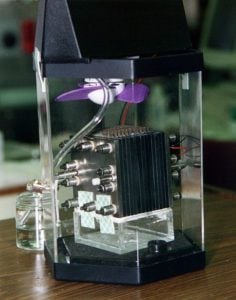Fuel cells have been around for a while now. So, it would make perfect sense that fuel-cell technology would eventually find application in the railway domain.
And, now it has.
Alstom, the French company, is one manufacturer getting into the game.

“The Coradia iLint is the first low floor passenger train worldwide powered by a hydrogen fuel cell, which produces electrical power for the traction,” Alstom in a Mar. 14, 2017 press release noted. “This zero-emission train is silent and only emits steam and condensed water. Coradia iLint is special for its combination of different innovative elements: a clean energy conversion, flexible energy storage in batteries, and a smart management of the traction power and available energy. Based on Alstom’s flagship Coradia Lint diesel train, Coradia iLint is particularly suited for operation on non-electrified networks. It enables sustainable train operation while maintaining high train performance.”
What is good about this technology is that propulsion occurs without any damage to air at all.
This is also true for conventional electric trains. But, unlike their fuel-cell counterparts, which generate their own electricity on board (power for the train does not come from a remote source), conventional electrics do not. And, for this reason, the fuel-cell version has an added plus.
“The vehicle has already successfully completed the static commissioning process. All electrical and pneumatic functions of the trains have been tested and verified at standstill. TÜV Süd has certified the safety of the battery, the pressure tank system and the fuel cell for the coming test phases.
“The Coradia iLint was designed by Alstom teams in Germany at Salzgitter’s site, centre of excellence for regional trains and in France notably in Tarbes, centre of excellence for traction systems and Ornans for the motors,” the French company in the release continues. “This project benefits from the support of the German ministry of Transport and Digital infrastructure. Alstom has already signed letters of intent for 60 trains with the German states of Lower Saxony, North Rhine-Westphalia, Baden-Württemberg and the Hessian transport association ‘Rhein-Main-Verkehrsverbund’.”
According to Alstom, extensive testing was to have commenced both in Germany and the Czech Republic prior to trains undergoing German-based passenger test runs on the Buxtehude-Bremervörde-Bremerhaven-Cuxhaven route, this planned for early next year.
2018 is practically right around the corner.
“The dynamic tests are performed at Salzgitter plant at 80 km/h and in Velim (Czech Republic) at up to 140 km/h, the maximum speed of the Coradia iLint. For the purpose of the tests, a mobile filling station has been erected in Salzgitter to pump gaseous hydrogen into the pressure tank of the Coradia iLint. The hydrogen used for the test runs is the by-product of an industrial process, which is reasonably reused as a waste product. In the long term, Alstom aims to support the hydrogen production from wind energy,” Alstom expressed.
That this latest in rail-transportation-propulsion techniques has been introduced, and provided all tests of Alstom’s hydrogen-powered passenger train come off without a hitch, then there is every expectation that fuel-cell-powered railway transport’s time has come. And, provided that is the case, this could very well prove to be the next generation in railway propulsion platforms.
Image above: NASA
– Alan Kandel

How much carbon is converted into CO2 in order to make the hydrogen? What we need is not pure energy conversion devices, however fast they can run, but energy sources which are not polluting. Besides, as our global village develops, we won’t need more trains.